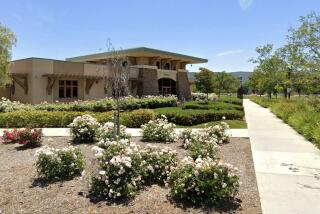Measure Would Require Security Doors at Banks
- Share via
THOUSAND OAKS — Hoping to bolster security following a fatal shooting at a local bank last spring, this city’s top police official is asking the City Council to examine the legality of an ordinance requiring bulletproof “anti-weapon doors” at every financial institution.
Cmdr. Kathy Kemp of the Ventura County Sheriff’s Department, which provides police services in Thousand Oaks, will take her proposal before the council tonight.
Kemp will ask the council to direct City Atty. Mark Sellers to study whether Thousand Oaks can demand such increased security measures at banks through building-code requirements.
The pricey access systems, currently in use at just two financial institutions in the county, contain a metal detector in the first of two sets of doors. If the first doors detect a gun or other large metal object, the second doors do not open.
Monica Lynne Leech, a 39-year-old mother of two, was killed during an April 29 robbery at Western Financial Savings on Thousand Oaks Boulevard, and city leaders have been looking for ways to increase bank security since that crime.
Carol Harris, president of the Ventura County Federal Credit Union, which uses the high-security doors at its Simi Valley branch, said they are relatively glitch-free and make patrons and employees feel safer.
But she said an across-the-board requirement, which would affect the credit union and about 40 other financial institutions in Thousand Oaks, may be more burdensome than necessary.
Each set of the security doors, installed by LeFebure Corp. and several other firms, costs between $45,000 and $60,000, depending on a building’s architecture. So a larger bank, with several entrances, would have to pay as much as $200,000 if the proposal became law, according to a city report.
“We have not been robbed since [the doors were installed in 1996], but I don’t know that you can pin that on the system,” Harris said. “It does provide more of a sense of security for our customers and employees. But to require every institution to do this, I think, is unrealistic,” she added.
“Everyone has different needs and ways of dealing with security. It should be up to the institution to find the best way to do things. Every financial institution is looking at ways to secure the premises,” Harris said.
Councilman Mike Markey said he is open to looking at whether requiring the doors is legal and practical. But he is concerned that Thousand Oaks may be over-regulating its businesses in its efforts to make the city’s banks safer.
“The biggest question I have is, should government be getting this involved in private businesses?” Markey said. “I don’t know if we can legally do it, and I don’t know if we should.
“Maybe we can do this with new business, but I doubt we can do it with existing banks,” he added. “And I don’t know how many new banks we’re going to have.”
Spokesman John Stafford of the California Bankers Assn., the primary trade group for the more than 300 commercial banks in California, said secure entrance systems are widely used in Europe and parts of the East Coast, but have never become popular in California.
“This is probably the most expensive and generally intensive response you can take,” Stafford said. “It can sense a gunman entering the bank, and automatically or at the push of a button either locks them between the two bulletproof doors or out of the bank.”
However, requiring the doors at every bank may be excessive, he said.
“Thousand Oaks has witnessed the worst bank robbery in California this year,” Stafford said. “It’s not an irrational response, but it may be unnecessary. We would never support that statewide, that’s for sure. It’s a little much to require a bank that has never been robbed to install a $60,000 security system for [detecting] guns.”
More to Read
Sign up for Essential California
The most important California stories and recommendations in your inbox every morning.
You may occasionally receive promotional content from the Los Angeles Times.













